Unlike my last “Where Were They Then?” entry, the photographic requirements for this post were a bit more demanding. While driving around the Superstition Mountains it was not difficult to pull over on a dirt road and start snapping away. For landmarks like Tempe Butte, Camelback Mountain, North Mountain, Red Mountain, etc. one runs the risk of being run over by freeway traffic, drowning in the Salt River, or being honked and yelled at on Phoenix streets.
 Maynard Dixon is a Southwestern art icon who likely needs no introduction. Dixon first came to Arizona in 1900 from his native state of California, heading “east to see the West.” He returned again in 1904, and then again in 1915 when he painted Tempe Butte, shown above right. Note the sandy wash in the foreground which is today covered by the Salt River shown in the photo. Painting image courtesy of David and Doreen Picerne Collection of Arizona Landmark Art.
Maynard Dixon is a Southwestern art icon who likely needs no introduction. Dixon first came to Arizona in 1900 from his native state of California, heading “east to see the West.” He returned again in 1904, and then again in 1915 when he painted Tempe Butte, shown above right. Note the sandy wash in the foreground which is today covered by the Salt River shown in the photo. Painting image courtesy of David and Doreen Picerne Collection of Arizona Landmark Art.
But I refused to be deterred -except where heavy commercial development made taking photos pointless. In some cases where the artists were “then” was easily determined. Not so with others. I confess to not being as talented in this arena as my long time client David Picerne, who can usually tell within seconds exactly where an artist had set up his or her easel.
“Go past Goldfield and drive another fifteen miles on the Apache Trail. Then turn around and you’ll be looking right at it,” he once told me after a quick glance a Gustave Baumann block print, “it” being the scene in the print.
“You’ve got to be kidding,” I silently said to myself. “There is no way you can know that.”
It turns out he was right.
So if anyone has any better ideas about where the respective artists might have been when they created the sketches for these pieces feel free to share it with us. Otherwise, enjoy the show.
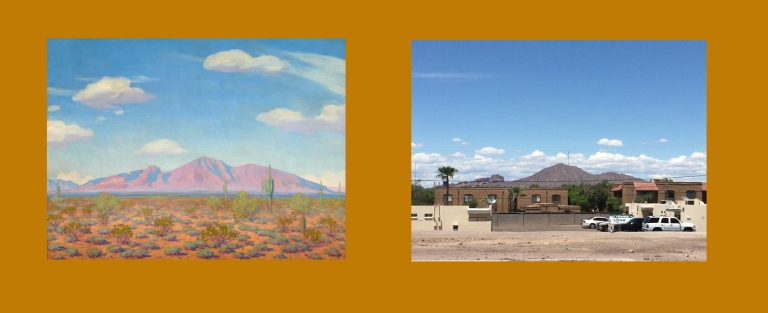 Camelback Mountain by Marjorie Thomas. Dated 1925. This viewpoint could be anywhere from the runway at Sky Harbor Airport to Van Buren and the 202 Freeway, where I shot this photo. Painting image courtesy of David and Doreen Collection of Arizona Landmark Art.
Camelback Mountain by Marjorie Thomas. Dated 1925. This viewpoint could be anywhere from the runway at Sky Harbor Airport to Van Buren and the 202 Freeway, where I shot this photo. Painting image courtesy of David and Doreen Collection of Arizona Landmark Art.
 Jessie Benton Evans was Phoenix’s first art maven and promoter. She moved to the area in 1913 from Illinois. According to her great granddaughter (also an artist with the same name) her grandmother hated the desert at first, then came to love it. She built an Italian style villa on her 200 plus acre estate on the south side of Camelback Mountain which quickly became the cultural center of Phoenix and Scottsdale. The Jokake Inn and the Phoenician were later built on her property. Obviously it was not difficult for her to “travel” to get a good view of Camelback Mountain, as shown here. All three were painted circa 1925. Today most of these perspectives are not even worth photographing. In many cases the only part of the mountain that can be seen is the “hump.” The rest is blocked by buildings. Along with Marjorie Thomas, Jessie Benton Evans was one of the few women artists to paint commissioned pieces for the Santa Fe Railway.
Jessie Benton Evans was Phoenix’s first art maven and promoter. She moved to the area in 1913 from Illinois. According to her great granddaughter (also an artist with the same name) her grandmother hated the desert at first, then came to love it. She built an Italian style villa on her 200 plus acre estate on the south side of Camelback Mountain which quickly became the cultural center of Phoenix and Scottsdale. The Jokake Inn and the Phoenician were later built on her property. Obviously it was not difficult for her to “travel” to get a good view of Camelback Mountain, as shown here. All three were painted circa 1925. Today most of these perspectives are not even worth photographing. In many cases the only part of the mountain that can be seen is the “hump.” The rest is blocked by buildings. Along with Marjorie Thomas, Jessie Benton Evans was one of the few women artists to paint commissioned pieces for the Santa Fe Railway.
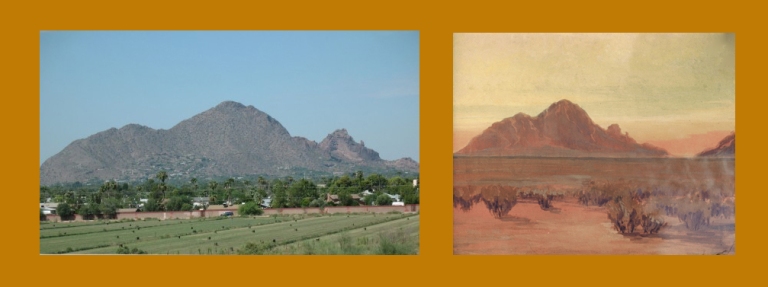 Then there’s the north side. Another Jessie Benton Evans, circa 1925. Photo taken from Indian Bend/101 Freeway area. I’m guessing the viewpoint to be somewhere in the vicinity of Taliesin West.
Then there’s the north side. Another Jessie Benton Evans, circa 1925. Photo taken from Indian Bend/101 Freeway area. I’m guessing the viewpoint to be somewhere in the vicinity of Taliesin West.
 Sunrise on Camelback by John Hilton. This painting appeared in Arizona Highways in either 1959 or 1960. Although more known for his southern California desert scenes, Hilton painted several areas in Arizona including Monument Valley, the Grand Canyon, and the Kofa Mountains. Painting image courtesy of David and Doreen Picerne Collection of Arizona Landmark Art.
Sunrise on Camelback by John Hilton. This painting appeared in Arizona Highways in either 1959 or 1960. Although more known for his southern California desert scenes, Hilton painted several areas in Arizona including Monument Valley, the Grand Canyon, and the Kofa Mountains. Painting image courtesy of David and Doreen Picerne Collection of Arizona Landmark Art.
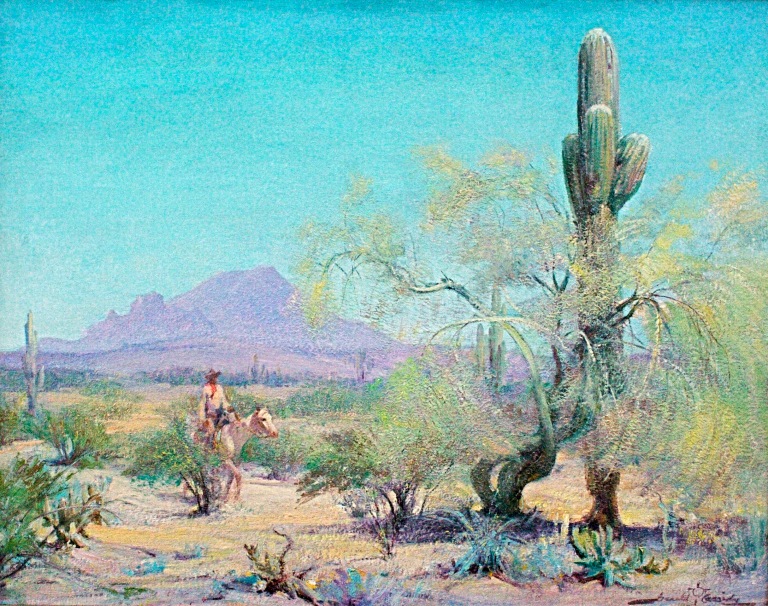 Lone Rider south of Camelback by Gerald Cassidy. Circa 1900. Cassidy was tutored by Frank Duveneck in Ohio. Duveneck helped develop many successful artists, including long time Paradise Valley resident Oscar Strobel. Cassidy came to the Southwest circa 1890 for health reasons. Although the exact date of this piece is unknown, it could be one of the earliest Camelback Mountain paintings still in existence. A founding member of the Santa Fe Artists’ Colony, Cassidy died suddenly in 1934 from lead poisoning while working on a WPA mural in Santa Fe. Image courtesy of the David and Doreen Picerne Collection of Landmark Art. This is one where it’s impossible to gain the same view today because of too many tall buildings. I’m guessing Cassidy was standing somewhere in what is today Tempe…Southern and the 101 maybe…or maybe a little further north.
Lone Rider south of Camelback by Gerald Cassidy. Circa 1900. Cassidy was tutored by Frank Duveneck in Ohio. Duveneck helped develop many successful artists, including long time Paradise Valley resident Oscar Strobel. Cassidy came to the Southwest circa 1890 for health reasons. Although the exact date of this piece is unknown, it could be one of the earliest Camelback Mountain paintings still in existence. A founding member of the Santa Fe Artists’ Colony, Cassidy died suddenly in 1934 from lead poisoning while working on a WPA mural in Santa Fe. Image courtesy of the David and Doreen Picerne Collection of Landmark Art. This is one where it’s impossible to gain the same view today because of too many tall buildings. I’m guessing Cassidy was standing somewhere in what is today Tempe…Southern and the 101 maybe…or maybe a little further north.
 Camelback Mountain by Lon Megargee. Megargee is considered Arizona’s first Cowboy Artist. He also designed and built at least six of his own homes, including Casa Hermosa, today the Hermosa Inn in Paradise Valley. Lons, the Inn’s restaurant, was named for him. Based on an old photo on the Hermosa Inn’s blog, I think it’s very possible this was painted near the site of the Inn today. 24 x 30 Oil on Canvas. David and Doreen Picerne Collection of Arizona Landmark Art.
Camelback Mountain by Lon Megargee. Megargee is considered Arizona’s first Cowboy Artist. He also designed and built at least six of his own homes, including Casa Hermosa, today the Hermosa Inn in Paradise Valley. Lons, the Inn’s restaurant, was named for him. Based on an old photo on the Hermosa Inn’s blog, I think it’s very possible this was painted near the site of the Inn today. 24 x 30 Oil on Canvas. David and Doreen Picerne Collection of Arizona Landmark Art.
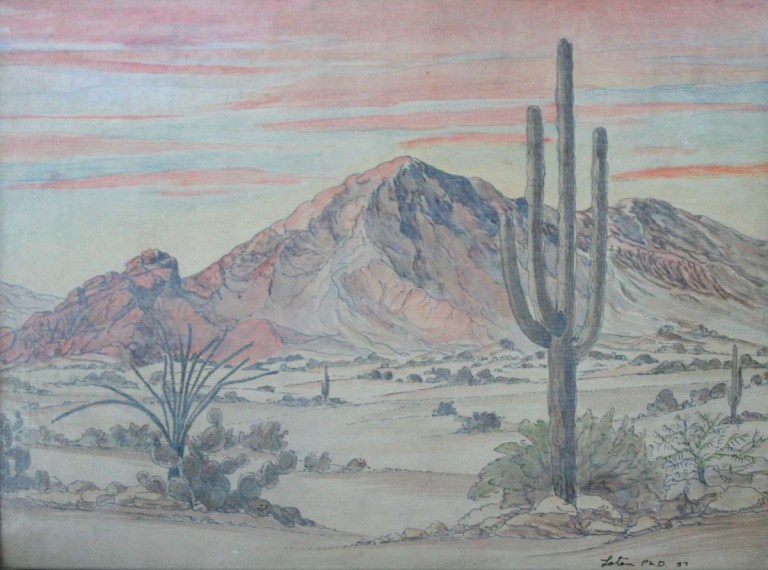 Lotan Lotan was one of the most pathological liars in Arizona art history. He frequently signed his paintings with his name and the designation “PHD” and “MD” even though he was neither. This piece is interesting because it is dated 1957, yet there are no signs any human encroachment. Then again maybe he just decided not to include them. His real name was Lotan Welshans. He is sometimes referred to as the “Dali of the Desert” because he left behind a large body of surreal work with Sonoran Desert settings. What vantage point did Lotan use for this one? I don’t know…somewhere around Papago Buttes? Courtesy of David and Doreen Picerne Collection of Arizona Landmark Art.
Lotan Lotan was one of the most pathological liars in Arizona art history. He frequently signed his paintings with his name and the designation “PHD” and “MD” even though he was neither. This piece is interesting because it is dated 1957, yet there are no signs any human encroachment. Then again maybe he just decided not to include them. His real name was Lotan Welshans. He is sometimes referred to as the “Dali of the Desert” because he left behind a large body of surreal work with Sonoran Desert settings. What vantage point did Lotan use for this one? I don’t know…somewhere around Papago Buttes? Courtesy of David and Doreen Picerne Collection of Arizona Landmark Art.
 Considered the Dean of the Santa Fe Art Colony, Warren Eliphalet (W.E. for short) Rollins spent a year painting Arizona in the early 1900s (sources vary on exactly what year) so this may be a good candidate for the oldest known existing painting of Camelback Mountain. 9 x 12 Oil on board. Image Courtesy of the Cormany Collection. I’m going to guess this is one of those where you might get run over by a 727 if you tried to find the exact spot.
Considered the Dean of the Santa Fe Art Colony, Warren Eliphalet (W.E. for short) Rollins spent a year painting Arizona in the early 1900s (sources vary on exactly what year) so this may be a good candidate for the oldest known existing painting of Camelback Mountain. 9 x 12 Oil on board. Image Courtesy of the Cormany Collection. I’m going to guess this is one of those where you might get run over by a 727 if you tried to find the exact spot.
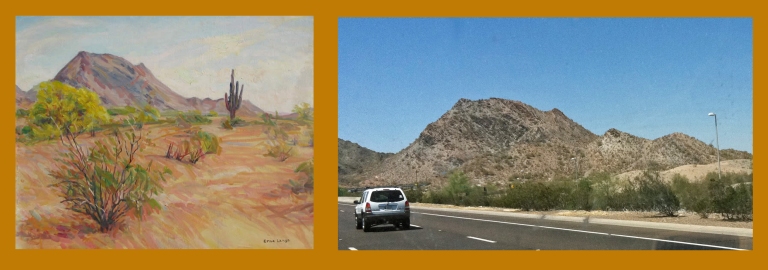 Educated in New York City and Paris, Erna Lange made several trips to Arizona in the 1930s before settling in Phoenix permanently in 1940. She opened a studio and gallery in the Dreamy Draw area, where she remained a resident until her death in 1984. I’ve met many people over the years who remember her studio shown in the photo below on Northern Avenue, just east of 16th Street. There she taught classes and sold her work. Her oeuvre includes a large number of landscapes of the Phoenix Mountains at a time when they were uninhabited. The painting above is North Peak, circa 1950. 24 x 30 oil on canvas. The 51 freeway is shown in the photo just before it veers to the east of North Mountain today. Image courtesy of Blue Coyote Gallery.
Educated in New York City and Paris, Erna Lange made several trips to Arizona in the 1930s before settling in Phoenix permanently in 1940. She opened a studio and gallery in the Dreamy Draw area, where she remained a resident until her death in 1984. I’ve met many people over the years who remember her studio shown in the photo below on Northern Avenue, just east of 16th Street. There she taught classes and sold her work. Her oeuvre includes a large number of landscapes of the Phoenix Mountains at a time when they were uninhabited. The painting above is North Peak, circa 1950. 24 x 30 oil on canvas. The 51 freeway is shown in the photo just before it veers to the east of North Mountain today. Image courtesy of Blue Coyote Gallery.
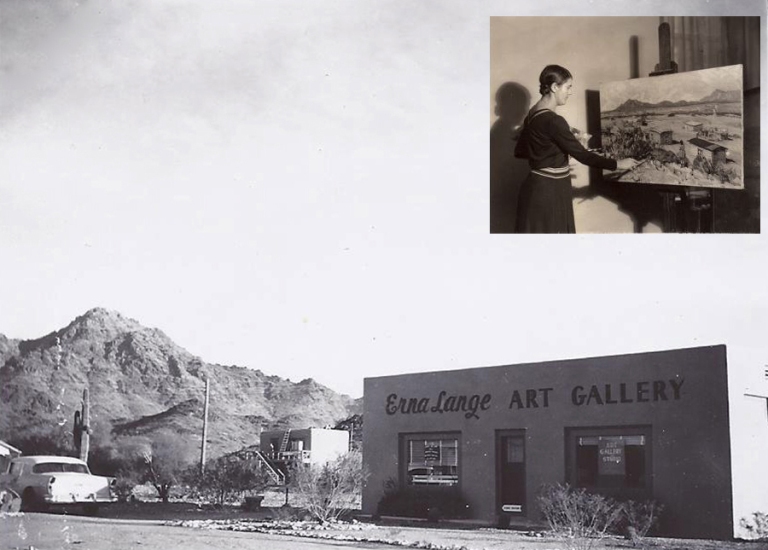 Erna Lange’s studio on Northern Avenue just east of 16th Street. Circa 1958. Her home can be seen in the background to the left of the gallery. Inset: Erna Lange at easel.
Erna Lange’s studio on Northern Avenue just east of 16th Street. Circa 1958. Her home can be seen in the background to the left of the gallery. Inset: Erna Lange at easel.
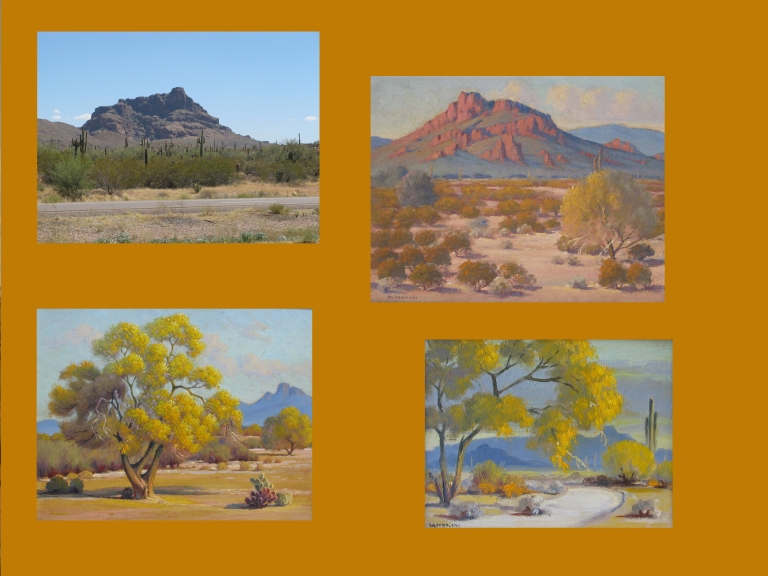 I believe the peak in all three of these Ralph Goltry paintings to be Mount McDowell, aka Red Mountain or Firerock near Fountain Hills. Back in the mid part of the 20th century it was also known as Granite Reef. It has been declared off limits to hikers and even tribal members by the Salt River-Pima Tribe after some ancient petroglyphs were vandalized in the early 1980s. Therefore close photography of the distinctive formation is difficult. This was not the case in Goltry’s day. He arrived in Phoenix in 1922 and was one of the founding members of the Arizona Artists Guild in 1928. He spent the next three decades painting the area extensively. With one exception (Saddle Mountain near Tonopah) every Goltry painting I’ve ever seen has featured Valley of the Sun landscapes. Upper right 14 x 18 Oil on board. Lower left 16 x 20 Oil on canvas. Lower right 6×8 Oil on board. One can drive into the scene in the lower right painting by heading east on Indian School from Scottsdale Road. Images courtesy of Blue Coyote Gallery.
I believe the peak in all three of these Ralph Goltry paintings to be Mount McDowell, aka Red Mountain or Firerock near Fountain Hills. Back in the mid part of the 20th century it was also known as Granite Reef. It has been declared off limits to hikers and even tribal members by the Salt River-Pima Tribe after some ancient petroglyphs were vandalized in the early 1980s. Therefore close photography of the distinctive formation is difficult. This was not the case in Goltry’s day. He arrived in Phoenix in 1922 and was one of the founding members of the Arizona Artists Guild in 1928. He spent the next three decades painting the area extensively. With one exception (Saddle Mountain near Tonopah) every Goltry painting I’ve ever seen has featured Valley of the Sun landscapes. Upper right 14 x 18 Oil on board. Lower left 16 x 20 Oil on canvas. Lower right 6×8 Oil on board. One can drive into the scene in the lower right painting by heading east on Indian School from Scottsdale Road. Images courtesy of Blue Coyote Gallery.
 David Swing was Phoenix’s first full time resident artist. Originally from Ohio, Swing moved to Los Angeles in 1892 at the age of 28. In 1917 he relocated to Phoenix where he remained until his death in 1945. A multi-talented man, Swing made his living at various times as an art instructor, interior designer, engraver, landscape artist, and muralist. He was also an accomplished violinist and trumpeter who played in orchestras in Cincinnati, Pasadena and Phoenix. According to Peter Bermingham, in “The New Deal in the Southwest”, no other Arizona WPA artist could match Swing for “sheer acreage of painted canvas”. In other words he was very prolific and he painted a lot of murals as well as small, medium, and large pieces. The painting shown here is clearly of the Bradshaw Mountains. 10 x 13 Oil on board. Courtesy of David and Doreen Picerne Collection of Arizona Landmark Art. The photo was literally taken from my back porch. However I’m going to guess Swing was approximately 30 miles northwest from my house, which would place this scene somewhere west of Black Mountain City.
David Swing was Phoenix’s first full time resident artist. Originally from Ohio, Swing moved to Los Angeles in 1892 at the age of 28. In 1917 he relocated to Phoenix where he remained until his death in 1945. A multi-talented man, Swing made his living at various times as an art instructor, interior designer, engraver, landscape artist, and muralist. He was also an accomplished violinist and trumpeter who played in orchestras in Cincinnati, Pasadena and Phoenix. According to Peter Bermingham, in “The New Deal in the Southwest”, no other Arizona WPA artist could match Swing for “sheer acreage of painted canvas”. In other words he was very prolific and he painted a lot of murals as well as small, medium, and large pieces. The painting shown here is clearly of the Bradshaw Mountains. 10 x 13 Oil on board. Courtesy of David and Doreen Picerne Collection of Arizona Landmark Art. The photo was literally taken from my back porch. However I’m going to guess Swing was approximately 30 miles northwest from my house, which would place this scene somewhere west of Black Mountain City.
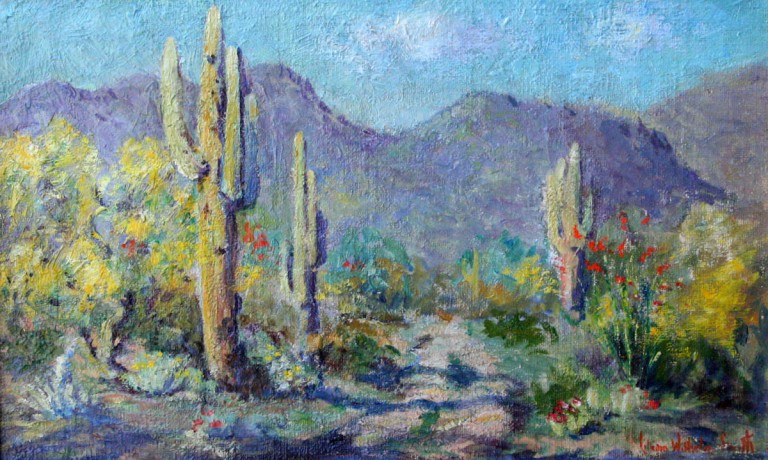 I know this viewpoint is just north of the Arizona Biltmore because the artist, Lillian Wilhelm Smith, wrote it on the back of the canvas. Born and raised in New York City, Smith came to Arizona for the first time in 1913 and became a permanent resident sometime in the early 1920s. She was a woman of many “firsts”, including the first artist to paint Rainbow Bridge, Havasupai Falls, and the Verde Valley from the Mingus Mountains. She illustrated at least a dozen of Zane Grey’s novels, the first being The Rainbow Trial. She was also the first “Artist in Residence” at the Biltmore Inn, when she created this painting. Circa 1932.
I know this viewpoint is just north of the Arizona Biltmore because the artist, Lillian Wilhelm Smith, wrote it on the back of the canvas. Born and raised in New York City, Smith came to Arizona for the first time in 1913 and became a permanent resident sometime in the early 1920s. She was a woman of many “firsts”, including the first artist to paint Rainbow Bridge, Havasupai Falls, and the Verde Valley from the Mingus Mountains. She illustrated at least a dozen of Zane Grey’s novels, the first being The Rainbow Trial. She was also the first “Artist in Residence” at the Biltmore Inn, when she created this painting. Circa 1932.


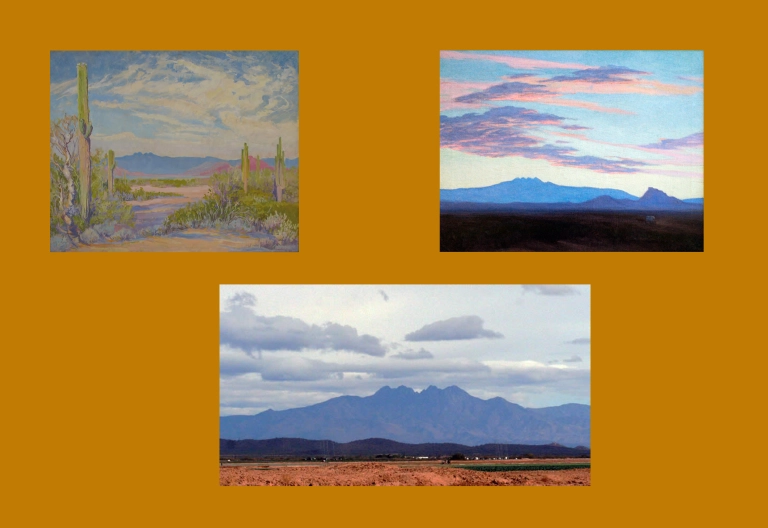 Time constraints have prevented me from trying to find the exact spots where Marjorie Thomas and Jessie Benton Evans might have set up their easels for these two. Today it’s hard to imagine the Valley of the Sun so pristine and empty, but Marjorie Thomas first came to Arizona in 1909 and could have very well have created the sketch for the painting in the top right shortly afterwards. 20 x 24 oil on canvas. The Evans painting epitomizes her great-granddaughter’s memories of visiting her great grandmother’s estate while growing up. “To the east, the pristine desert expanded unbroken towards our favorite mountains which shimmered in the light–Four Peaks, Superstition, Granite Reef (now called Red Mountain) and the McDowells.” Jessie Benton Evans-The Younger.”Memoir and Biography of Jessie Benton Evans, 1866-1954, Historic Arizona Landscape Painter” 36 x 48 Oil on canvas. Courtesy of David and Doreen Picerne Collection of Arizona Landmark Art.
Time constraints have prevented me from trying to find the exact spots where Marjorie Thomas and Jessie Benton Evans might have set up their easels for these two. Today it’s hard to imagine the Valley of the Sun so pristine and empty, but Marjorie Thomas first came to Arizona in 1909 and could have very well have created the sketch for the painting in the top right shortly afterwards. 20 x 24 oil on canvas. The Evans painting epitomizes her great-granddaughter’s memories of visiting her great grandmother’s estate while growing up. “To the east, the pristine desert expanded unbroken towards our favorite mountains which shimmered in the light–Four Peaks, Superstition, Granite Reef (now called Red Mountain) and the McDowells.” Jessie Benton Evans-The Younger.”Memoir and Biography of Jessie Benton Evans, 1866-1954, Historic Arizona Landscape Painter” 36 x 48 Oil on canvas. Courtesy of David and Doreen Picerne Collection of Arizona Landmark Art.
I found some paintings in my barn by jessie gray. Id love to show you. Im in Syracuse indiana.
Yes, I would love to see them. Jessie was a good friend of mine. Please send them to
gary@bluecoyotegallery.com